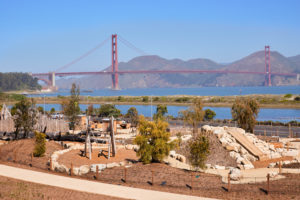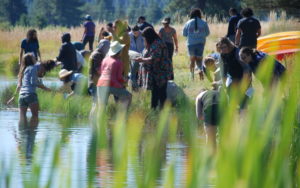Sure, the nights are getting colder, but if you like looking at the stars, there’s no better time than winter. Early sunsets mean you get in more stargazing and can still get to bed on time. When it’s not raining, the sky tends to be clearer in the winter. And, because of the tilt of the earth’s axis, some of the brightest stars in the sky are visible to us only in the winter.
A few of these bright stars form the Winter Hexagon, a shape easy to see in a clear, dark sky. Looking at these bright stars, we can learn a lot about the different sizes and ages of stars in our galaxy and also get a sense of how far away they are.
Color is a sign of a star’s surface temperature. Hot stars are blue, medium stars are white to yellow, and cool stars are red. A bright star may be close to us or just really big. A star that is both far away and bright has to be huge!
Rigel, the bright left foot of Orion, is just such a star. It is farther from us than any other bright star in the sky–900 light-years away, about 5,400 trillion miles (a light-year is the distance light travels in 365 days). It glows a brilliant blue-white. So far, so bright! It is a supergiant, 18 times the mass of our star, the sun.
Sirius, the twinkler of “twinkle, twinkle, little star,” is the star that appears brightest in our sky. You can find it by following the line of Orion’s belt to the east. It sparkles blue, red, and green as it rises because Earth’s atmosphere acts like a prism near the horizon. When higher up, Sirius looks like a blue-white diamond in the sky. Sirius is the closest star we can see from the United States (8.8 light-years away). It is not very big (only twice the sun’s mass) but its nearness makes it appear bright.
Procyon, the bright star of the Little Dog constellation, glows yellow-white because it is medium hot and not very large (about 1.5 times the mass of our sun). Stars of this size live for billions of years before they run out of hydrogen fuel to burn.
Both Pollux and Aldebaran (across from each other on the Winter Hexagon) are cool, red-orange giants. Of the stars we can see, Pollux is the brightest star that also has a recently discovered planet orbiting it. When you are looking up at it, maybe someone there is looking back at you!
Then there’s Betelgeuse, another cool, red-orange supergiant that is the largest star within 1,000 light-years of us. It would fill our solar system out to the orbit of Jupiter!
Big stars like Betelgeuse live fast, die young, and leave a very dense corpse. It started out as a very heavy star (20 times the sun’s mass) and quickly burned up its hydrogen fuel. It is now only a few million years away from being an explosive supernova that will light up our sky as brightly as a crescent moon. After that, Betelgeuse will shrink to the size of a small town, and a piece of it the size of a sugar cube will weigh 17 tons!
If we wanted to see our sun explode–and we don’t!–we’d have to wait another five billion years. I’m getting tired just thinking about it. Time to go to bed.
SIDEBAR
Get Out Stargazing
The great thing about stargazing is you can do it anywhere there’s a clear view of the night sky. Of course the less city light, the better. But even in town, you can help scientists study light pollution by participating in the Great World Wide Star Count, October 14-28. Just go outside after dark, count the stars you see in the constellation Cygnus (the swan), and report back online [info at http://bit.ly/okukel].
Viewing stars through a telescope is always exciting. The biggest telescopes are at observatories, and we’re lucky to have quite a few in the Bay Area that offer viewing when skies are clear. In the North Bay, Sugarloaf Ridge State Park’s Robert Ferguson Observatory offers monthly stargazing [rfo.org, (707)833-6979]. Or head to Oakland’s Chabot Space and Science Center for stargazing on Friday and Saturday nights [chabotspace.org, (510)336-7300]. In the South Bay, view the stars at the Foothill College Observatory in Los Altos every Friday evening [info at http://bit.ly/ovgVpS].
Some of the friendliest telescopes belong to local amateur astronomers. Like the Hercules Stargazers [http://bit.ly/qFIsXA], many of these groups meet regularly, love to talk about stars, and post star party dates and other information on their websites. You can find out about many more astronomical societies and observatories by visiting BayNature.org/stargazing. –Sue Rosenthal




